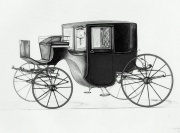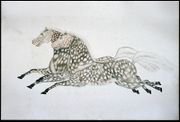Bristol board
Description
A high quality, stiff, glazed, white Cardboard. Originally made in Bristol, England around 1800, Bristol boards, or Bristol papers, were name for the Earl of Bristol who was associated with visiting cards and the fine arts. Early papers were often made by local stationers. Bristol boards are typically supercalendered to produced a smooth surface, but can also be found textured as vellum or with a rough finish. The surface is favored for drawing with pen and ink as well as printing. The boards are now categorized into three main classes: printing bristols, index bristols, and wedding bristols. Printing bristols have a stiff, printable surface. They are used for advertising, posters, displays as well as pen and ink drawings and paintings. The U.S. Patent Office requires trademark and patent images be drawn on Bristol board. Index bristols also accept printing and writing well and are extremely erasable. They are used as booklet covers, file cards, postcards, and menus. Wedding bristols are made with decorative finishes, such as vellum or antique plate. Bristol boards are available in various plies and have been used in museums for interleaving, dividers and supports.
Synonyms and Related Terms
bristol (Fr.); Bristol paper; illustration board
Applications
Interleaving, dividers, supports.
Collection Risks
Some Bristol boards are not archival quality. Choose lignin-free boards with a neutral pH.
Forms/Sizes
Common sizes include 22 1⁄2 in × 28 1⁄2 in (572 mm × 724 mm) and its bulk thickness is 0.006 inches (0.15 mm) or higher[2] and A4, A3, A2 and A1. Bristol board is typically white, but can now be found in multiple colors.
Resources and Citations
- J.Krill, English Artists Paper, Trefoil Publications, London, 1987, p. 139-140.
- Rachael Perkins Arenstein, Lisa Goldberg, and Eugenie Milroy, ‘Support and Rehousing for Collection Storage’ In ‘Preventive Conservation: Collection Storage’ Lisa Elkin and Christopher A. Norris (eds.), Society for the Preservation of Natural History Collections, New York. 2019.
- Ralph Mayer, A Dictionary of Art Terms and Techniques, Harper and Row Publishers, New York, 1969 (also 1945 printing)
- Boise Cascade Paper Group, The Paper Handbook, Boise Cascade, Portland OR, 1989
- Matt Roberts, Don Etherington, Bookbinding and the Conservation of Books: a Dictionary of Descriptive Terminology, U.S. Government Printing Office, Washington DC, 1982
- Book and Paper Group, Paper Conservation Catalog, AIC, 1984, 1989
- The Dictionary of Paper, American Paper Institute, New York, Fourth Edition, 1980
- E.J.LaBarre, Dictionary and Encyclopedia of Paper and Paper-making, Swets & Zeitlinger, Amsterdam, 1969
- Silvie Turner, Which Paper?, Design Press, New York, 1991
- Art and Architecture Thesaurus Online, http://www.getty.edu/research/tools/vocabulary/aat/, J. Paul Getty Trust, Los Angeles, 2000
- Roy Perkinson, contributed information, 1998
- G.S.Brady, Materials Handbook, McGraw-Hill Book Co., New York, 1971 Comment: p. 583


